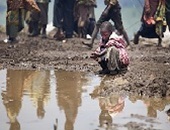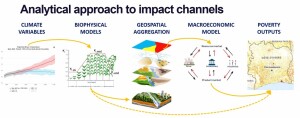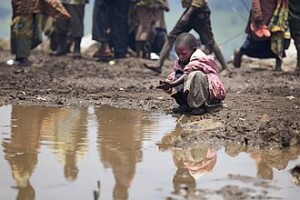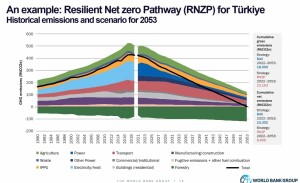For developing countries, how will climate change affect the progress of their economic development? Will these countries be able to use available opportunities through institutions such as the World Bank to adapt to changing conditions and improve people’s lives?
 “Development and resilience are mutually reinforcing,” said Stéphane Hallegatte, Senior Climate Change Adviser at the World Bank. “Development contributes to resilience, and resilience is crucial for safeguarding gains from increasingly frequent crises.” He was speaking at a webinar on September 5, 2024, on economic development in a changing climate. This was part of the series of talks sponsored by the Federal Reserve Bank of San Francisco (FRBSF), titled the Virtual Seminar on Climate Economics (VSCE).
“Development and resilience are mutually reinforcing,” said Stéphane Hallegatte, Senior Climate Change Adviser at the World Bank. “Development contributes to resilience, and resilience is crucial for safeguarding gains from increasingly frequent crises.” He was speaking at a webinar on September 5, 2024, on economic development in a changing climate. This was part of the series of talks sponsored by the Federal Reserve Bank of San Francisco (FRBSF), titled the Virtual Seminar on Climate Economics (VSCE).
Hallegatte is concerned that “countries are not capturing readily available opportunities to adapt to climate change and build more resilient economies.”
He gave an overview of the Country Climate and Development Reports (CCDRs) from more than 45 developing countries. Their reports contained information on greenhouse gas (GHG) emissions, amount of tropical forested area, disaster losses, and so on, in addition to the standard data of economics such as the population and gross domestic product (GDP). These country-specific reports were published around the time of the COP27 (2022 United Nations Climate Change Conference) or since then. In a few cases, they are still in preparation.
It’s a lot of data, but how is it used? Different channels generate economic, social and environmental impacts, including supply chains, employment multipliers, and technological spillovers. The figure below shows the analytical approach to impact channels, beginning with climate variables, developing biophysical models, and then using geospatial aggregation to build a data world.
The channels can be “hooked” to macroeconomic models in order to predict outcomes of climate scenarios. For example, heat stress affects labor productivity, which is an input variable to economic models.
“Lower-income countries are more vulnerable,” Hallegatte noted, “and effects on well-being include poverty, gender inequality, food insecurity, and impacts on health.” For example, in DRC, the poverty rate could increase by nearly 8 percent due to climate change, pushing 16 million people into poverty by 2050.
“Adaptation is a great investment,” he said, “but it alone cannot completely prevent climate impacts. Even the most efficient adaptation cannot replace emission reductions, especially in high-income countries and other big emitters.”
His research models the macroeconomic consequences of natural disasters, looking at capital stock, recovery dynamics, and monetary policy. The models contain three innovations:
- They distinguish infrastructure from non-infrastructure assets.
- They represent the impact of the disaster on the capital stock—plus productivity.
- They represent realistic reconstruction timeline and constraints.
How much would it cost to make developing countries have resilient, low-emission economies? In the World Bank summary of 45+ CCDRs, the annual incremental needs for this goal are estimated to be between 0.4 to 10 percent of GDP.
“The private sector has a key role to play in meeting investment needs,” he said, “and also innovation, faster technology adoption, and new business models.” To incentivize private sector involvement, he suggested countries need to develop a framework to mitigate credit, foreign exchange, and market risks.
The modeling assesses costs and benefits, opportunities and trade-offs. The figure below shows one such model from Turkey’s CCDR report. (Each industry sector is shown by a different color.)
Lower-income countries have higher financial needs. The figure below shows estimated costs to implement projects for resilience, low-emission, and both. (For the vertical axis, the amounts are expressed as percentages of the annual GDP 2023-2030 for each country.)
The World Bank report goes into greater detail.
Hallegatte closed on a hopeful note. “Low-emission development can foster similar—or even faster—economic growth and poverty reduction as current development pathways.”
“This requires a supportive, enabling environment and macroeconomic context, well-designed policies, management of negative impact in some sectors, communities, and regions,” he said, “and stronger financial and technical support from high-income countries and the international community.” ♠️
The graphs in this posting are from the VSCE webinar presentation. Permission pending.
The image of the child at the mudpuddle is from Kitshanga: © MONUSCO/Sylvain Liechti.





